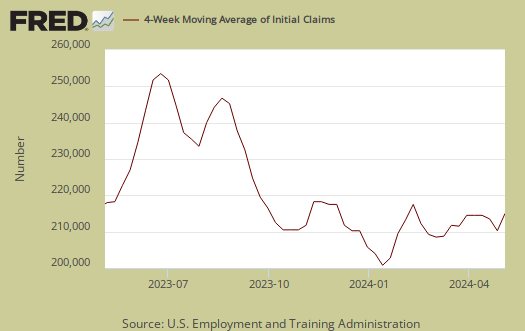Initial weekly unemployment claims for the week ending on September 17th, 2011 were 423,000. The DOL reports this as a decrease of 9,000 from the previous week. But the previous week was revised, from 428,000 to 432,000, an increase of 4,000.

Every week initial unemployment claims is revised. One simply cannot compare the reported numbers on a week to week basis due to the lag in States reporting claims data and revisions. Why investors, traders and the press focus on such a volatile and always revised number is beyond logic. Bottom line, one needs to at minimum look at the 4-week moving average, which increased to 421,000, up 500 from last week's, revised, 420,500.
Below is the 4 week moving average, set to a logarithmic scale to remove even more statistical noise, for the last year. As you can see, initial claims are higher than earlier in the year.

The magic number to show job creation is at minimum, below 400,000 initial unemployment claims, per week. Most Economists will quote 375,000 as the magic number to indicate job growth.
Below is the mathematical log of initial weekly unemployment claims, so one can get a better sense of the rise and fall of the numbers. A log helps remove some statistical noise, it's kind of an averaging. As we can see we have a step rise during the height of the recession, but then a leveling, not a similar decline.... Every week initial unemployment insurance claims hover around 400,000, refusing to really drop, a never ending labor malaise for most of the time after the recession ended in July 2009.

Below is the 4 week moving average, set to a log scale, from April 1st, 2007. We are nowhere near pre-recession initial weekly unemployment claims levels.

The insanity of Wall Street reacting to this report is true herd behavior. Weekly initial unemployment claims are statistically noisy, the numbers are always revised, there is large variance because it's a weekly data report instead of monthly, and only through a long term pattern can one say anything about the unemployment situation.
Continuing unemployment claims dropped but bear in mind people can plain being running out of benefits.
The advance number for seasonally adjusted insured unemployment during the week ending September 10 was 3,727,000, a decrease of 28,000 from the preceding week's revised level of 3,755,000. The 4-week moving average was 3,742,000, a decrease of 6,500 from the preceding week's revised average of 3,748,500.
In the week ending September 3rd, not seasonally adjusted, the raw number was 6,889,058 official people obtaining some sort of unemployment insurance benefit. Officially, there are 14.0 million unemployed and if one takes all of the people who want a job, including those stuck in part-time because they can't get anything else, the number is over 29 million.

Recent comments